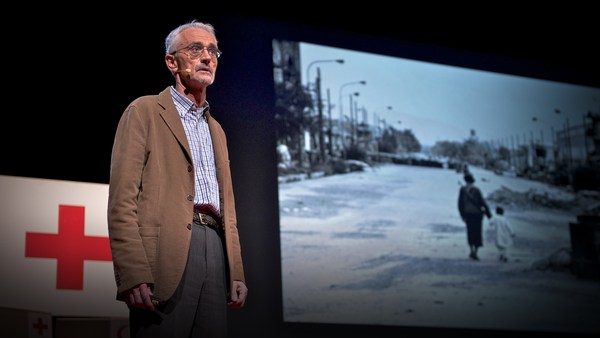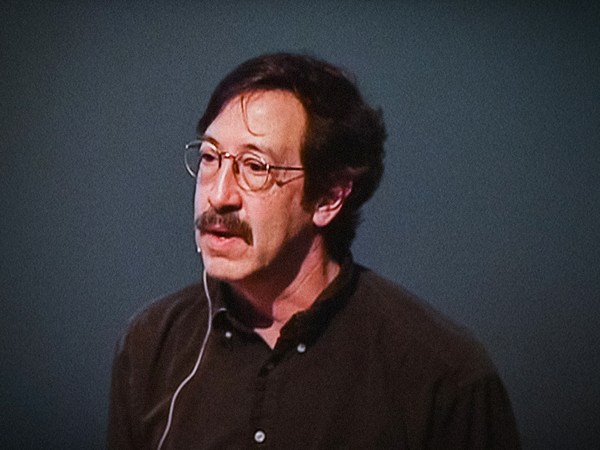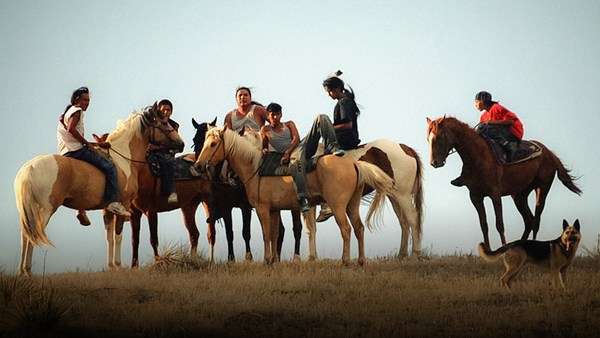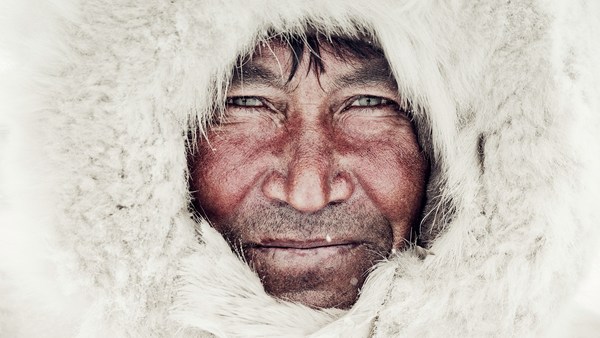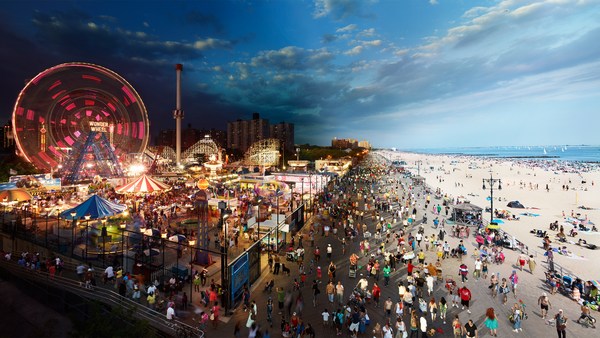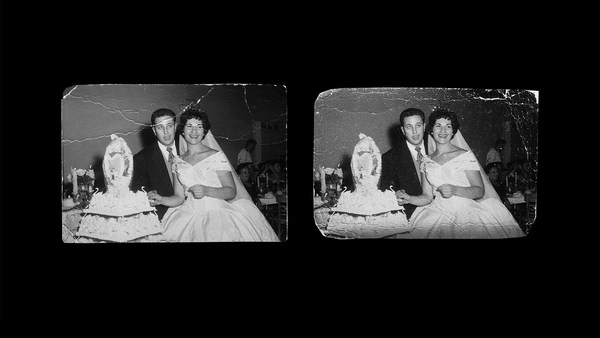Good morning, everyone. When I was first asked to do a TED Talk, I Googled to try and find out a little bit more about, you know, how it felt to be giving one. And one of the first things I read was a speaker in the States saying that she felt fine until she came onstage, and then she saw the timer ticking down.
(Laughter)
And it reminded her of a bomb. I was thinking, "That's the last thing I need."
(Laughter)
(Applause)
Anyway, it's a great privilege to be here. I think it's a bit of a joke for an editor of a paper to choose a photographer to open a speaking event.
(Laughter)
We're not renowned for our words, and I spent the last 40 years hiding behind a camera so I didn't have to speak. But I'm here today, and what I want to talk about are stories and the importance of stories to me and, I think, the importance of stories to everybody. I'm sure today you'll hear a lot of stories and, by listening to other people's stories, I think we can learn about the world, about other people and get a better understanding. So I want to talk about three stories that I've done as a photographer, and how they've inspired me, and how, in my life, I've become a part of the stories that I document myself.
As John said, I was a fashion photographer and music photographer for 10 years. I enjoyed it, I had a lot of fun, but always wanted to do something more with my work. And storytelling was always something I wanted to do. So 10 years ago, I set out to travel the world, to go and photograph other people in their situations and to record their stories, to bring them back, so that other people might understand. But this didn't happen overnight. When I worked as a music photographer and a fashion photographer, I always had this nagging feeling that there was something missing, that I wasn't quite using my skills productively. And it may seem very obvious, the link, now, but at the time, I couldn't really work out how could I use my photography to do something useful. So I gave up photography. I walked away from it completely and decided to do care work.
As a care worker, I started looking after a young guy called Nick. Nick has autism, very severe autism. But over the years of looking after him, we became very close friends. I would give him a 24-hour care, we would go off and do things from swimming, going for walks ... all sorts. Bit by bit, though, as I got to know him better, I realized that his story wasn't being told. He self-harmed, he would punch himself quite a lot in the face. And nobody really got to see that. So this is Nick. He used to describe his life as living downstairs at a party. He said he could hear the party in the kitchen, but he felt like he was always trapped in the basement, in his own little world, wanting to be part of the party but not able to walk upstairs. So I documented his life. I started to photograph it, not really with any intention of doing anything with the pictures, but just as a way of recording.
And as I started doing that, I realized that I could tell somebody's story through my photographs. As I said, Nick would self-harm. He would punch himself in the face. And nobody really got to see that. As we built up a kind of closer friendship, he finally would allow me to actually see him doing this and to document it. It was a moment of trust. The social services were not particularly good at helping Nick, and they said that he wouldn't be self-harming as bad as we said.
So one day, I took a photograph of when he'd really been self-harming. We took that to the social services, and their reaction was immediately incredibly different, and they managed to get a lot of help. And I'm glad to say now, eight years later, I actually spoke to Nick last night, and he wanted to let me know that he was feeling a lot better, and he doesn't do the self-harming anymore. And in some small way, I hope that the photographs was a part of that process. The main thing it did is it inspired me to go out with my camera and to tell other people's stories.
One of the stories I did was in Kutupalong, on the border of Burma and Bangladesh. Here, the Rohingyas refugees have been left, pretty much to rot, for over 20 years. This is a picture of the unofficial camp. At the top, you can see the official UN camp. All these huts are the unofficial camps. Literally, the raw sewage runs through the camp. The people there have been forgotten, so I thought it was important to go and document their stories. So I arranged with the village elder; the people would come along the next day, and I would take portraits of all these people and record their stories. So as the time went on, I turned up in the morning, I put a big, white sheet up, and I started to photograph these people.
Suddenly, though, everything got a bit out of control, and, although it was still dawn, we were filled in this small little compound we had made with literally hundreds of people turning up with ailments and diseases and just ... a hopeless situation. And that's exactly what their situation is -- helpless. A child with a tumor that nobody helped, who was slowly suffocating. I got in a bit of a panic, because these people were coming up to me, desperate, and I was trying to explain to the village elder that I was not a doctor, and I couldn't help these people. And the village elder turned to me and he said, "No, it's really important; these people know you're not a doctor, but at least somebody is now telling their story, and somebody is recording what is happening to them." And it was a good moment for me. It was a realization that maybe it was worthwhile going off and doing these things.
Another story that inspired me was in Odessa, in Ukraine. I was documenting a bunch of street kids. I ended up actually living with them in a squat, which I can say was an experience. Many late nights of vodka-fueled violence with me sitting in the corner with my bag, just going, "When was this a good idea?"
(Laughter)
I would say it's moments like that when I think, "Why did I leave the fashion world?"
But they were great kids, and on the last day, they took me down to the sea for a sort of trip, a sort of farewell. There they are, drinking vodka. And then Serge, who was the oldest and the most violent -- he'd just got out of the prison for stabbing somebody -- comes and puts his arm around me and says, "We go swimming." Now, I have to say, I had a "Lonely Planet" guide to Ukraine and in it, it gave some advice. And in that advice was, "Do not talk to the street kids, at no point leave your baggage unattended and in all counts, do not go swimming."
(Laughter)
So I was like, "I don't know if this is a good idea." Serge has got his arm around me. I'm like, "OK." So there I am.
(Laughter)
I literally handed all my cameras, all my equipment, to these street kids. And they took it. It's kind of funny to know, if you look in the background, you can see the other street kids who didn't get in the water go, "Why would you get in that water?"
But one of the little kids, Lilic, he was the one who had taken my camera, and he started taking photographs. He was really excited by this camera. And we talked a lot about how I was going to get him a camera and would return and we could start to teach him photography. He had a real eye for things. That's him, there. That was taken on the last evening I was there. I'd been staying there, but that night, I left to go and collect my things. And when I came back in the morning, he was dead. He had taken a lot of pills and a lot of vodka. And he had passed out in the night and didn’t recover. Again, it was another reminder of maybe why I should record these people's stories: because their lives are important, and it's important for me to document them.
Then in February of last year, when I was on patrol in Afghanistan, I stepped on an IED. That's me down there, somewhere. I became part of the story. At first, I was devastated by what had happened, obviously. I thought my work was over, I thought -- everything didn't make sense to me. And then I realized: I never set out to Congo, to Angola, to Bangladesh to take photographs. I went to those places because I wanted to make some kind of change, and photography happened to be my tool.
And then I became aware that my body was, in many ways, a living example of what war does to somebody. And I realized I could use my own experience, my own body, to tell that story. And it was also by looking back at the other people I've documented. I thought of Nick, and I thought of his resilience. I thought of the Rohingyas and the fact that they have no hope. I thought of Lilic and a lost life. And in fact, it was the stories that I've documented that inspired me to get through the last year, to survive, to get back up on my new legs and to be able to come and tell their stories, but also my own story.
So I did a self-portrait, because I wanted to show everybody what a bomb does to somebody, but also to show that losing your limbs doesn't end your life; that you can have what people say is disability, but not be disabled; that you can be able to do anything if you put your mind to it and have belief in it. It's strange, but in many ways I look at where I was a year ago, and I look at where I am now, and I realize that I have a lot of things I didn't have then. I wouldn't be sitting here right now if this hadn't happened. I wouldn't have been able to show you those photographs and tell you those stories. I was lucky 10 years ago, when I sat down and I tried to work out what I could do to make a difference in this world. I realized that my photography was a tool and a way to do it.
I think that's what's really key. It's that we all can be part of that wheel. We can all be cogs in a wheel of change. We can all make a difference. Everybody here has an ability to use something to make a difference to the world. We can all sit in front of the TV and go, "I don't know what to do about it," and forget about it. But the reality is that we can all do something. It might be just writing a letter. It might be standing on a soapbox and talking. It might be just recording somebody's story and telling it to somebody else. But every single one of us here, if we want to make a difference, we can, an there is nothing to stop us. And we all have our own experiences that we can use as well.
So really, that's all I wanted to talk about today. I just wanted to say that life goes on all around the world. People are going through terrible things. Everyone of us is going through our own terrible experience. But if we share those and we talk about stories, then we can inspire each other to get through our own bad experiences. I know that the people I've recorded have gotten me to this point. And I hope in some small way, the stories I've been able to tell you will help you get through things. And in turn, I hope you will use your experiences to help others.
Thank you very much.
(Applause)
